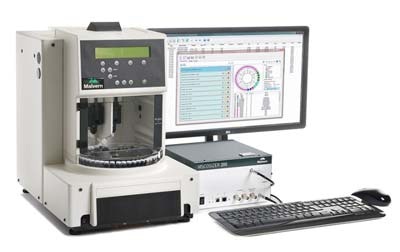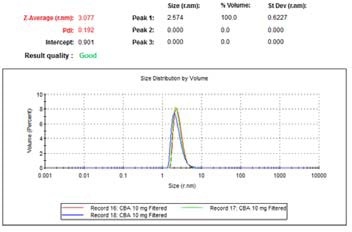The Malvern Panalytical Viscosizer 200 system can automatically measure viscosity in extremely low sample volumes and is also capable of measuring molecular size. Using light scattering technologies, such as dynamic light scattering (DLS) or static light scattering (SLS) for sizing proteins and other molecules can prove difficult at low concentration and molecular size, or in the presence of contaminants or precipitates.
To overcome these problems, the Viscosizer 200 system uses UV area imaging and Taylor Dispersion Analysis to calculate hydrodynamic radii and to determine the molecular diffusion coefficient in an innovative way. The system uses very little sample, typically < 10nL label-free, and is compatible with biological matrices, complex buffers and solvents, and colored sample and solutions that include contaminants.
The Viscosizer 200 uses sophisticated microcapillary technology and can detect extremely low concentrations: > 0.2mAU equivalent to < 0.05mg/mL lysozyme. In this article, the Viscosizer 200 is used to investigate protein and small molecule sizing analysis and how this technology complements light scattering technologies in the protein characterization workflow is also discussed.

Figure 1. Viscosizer 200.
Methodology
First, bovine carbonic anhydrase was prepared to a final concentration of 10 mg/mL in 10mM HEPES buffer. Then, 10mM HEPES buffer was formulated by diluting 1M HEPES stock solution with Fresenius sterile water and adjusting to pH 7 with 0.5 M sodium hydroxide or 0.25 M hydrochloric acid.
Following this, caffeine was prepared at 1mg/mL with Fresenius sterile water and sterile-syringe filtered to 0.02 µm. Then, warfarin was prepared to 0.1 mM and 1 mM in 100% dimethyl sulfoxide (DMSO) and sterile-syringe filtered to 0.02 µm. All measurements were performed at 25o?C and settings of the instrument were adjusted to offset for buffer viscosity. The Viscosizer 200 was equipped with a 214nm UV filter.
Results and Discussion
Using the Viscosizer 200, 10 mg/ml carbonic anhydrase (CBA) was examined, as shown in figure 2. The hydrodynamic radius (RH) was calculated as 2.7 nm. This size was validated by measuring the same solution on the Zetasizer Nano ZSP instrument following filtration.
This high-sensitive instrument utilizes the Non-Invasive Back Scatter (NIBS) technique to precisely calculate the molecules’ size in solution. The RH is measured by this instrument as 2.6 nm, as illustrated in figure 3, which closely agrees with the value of 2.7 nm acquired using the Viscosizer 200. This shows that the Viscosizer 200 can be utilized orthogonally to deliver precise size data for samples that are unmodified, unfiltered and undiluted.

Figure 2. Measurement of the size of CBA using the Malvern Panalytical Viscosizer 200: 10 mg/mL CBA in 10mM HEPES buffer, pH7, unfiltered. Hydrodynamic radius is calculated as 2.7 nm with very good data fitting between modeled and experimental data.

Figure 3. Measurement of RH of CBA using the Malvern Panalytical Zetasizer Nano ZSP: 10 mg/mL CBA in 10 mM HEPES buffer, pH7, filtered. Peak 1 = 2.6 nm RH. A total of three data sets were collected.
Viscosizer 200 for Sizing Small Molecules
The Viscosizer 200 system employs highly sensitive UV area imaging to identify UV-active molecules inside a sample, thus making the technique suitable for analyzing UV-absorbing small molecules which cannot be analyzed through the DLS technique due to their small size. Here, the instrument was utilized to calculate the hydrodynamic radii of warfarin (308.33 g/mol) and caffeine (194.19 g/mol).
Conclusion
The Viscosizer 200 is an advanced analytical instrument and is capable of measuring the size of proteins precisely and reproducibly, even in the presence of contaminants when filtration is not possible. The instrument can be utilized orthogonally with dynamic light scattering systems for sizing application.
Sizing by mass-weighted UV absorbance makes the system perfect for measuring micro-sized molecules at low concentrations, which otherwise may prove difficult for light scattering techniques.
About Malvern Panalytical
Malvern Panalytical provides the materials and biophysical characterization technology and expertise that enables scientists and engineers to investigate, understand and control the properties of dispersed systems.
These systems range from proteins and polymers in solution, particle and nanoparticle suspensions and emulsions, through to sprays and aerosols, industrial bulk powders and high concentration slurries. Used at all stages of research, development and manufacturing, Malvern Panalytical’s instruments provide critical information that helps accelerate research and product development, enhance and maintain product quality and optimize process efficiency.

This information has been sourced, reviewed and adapted from materials provided by Malvern Panalytical.
For more information on this source, please visit Malvern Panalytical.